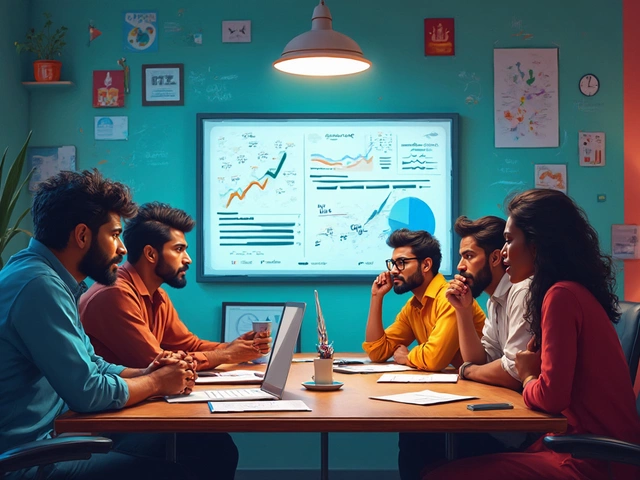Amazon might seem unbeatable, but in India, things play out differently. If you’ve shopped for sneakers, a new phone, or even diapers in India, you’ve probably noticed Flipkart almost always pops up as another option, sometimes with better deals or delivery times. Flipkart’s not just another store—it's Amazon's most serious challenger in the country.
Shopping in India is its own beast. Cash on delivery, local payment wallets, and festival sales all change the game. While Amazon tries to bring its global style, Flipkart knows how to play by the local rulebook. It’s not just about price—it’s about convenience, trust, and who actually understands what Indian buyers want. This rivalry decides where millions of shoppers land, and shapes what sellers do, too.
- Why Amazon Fears Flipkart
- Flipkart’s Homegrown Edge
- How India Shapes the Battle
- Tips for Shoppers and Sellers
Why Amazon Fears Flipkart
If you think Amazon is always number one, India might surprise you. Flipkart started way back in 2007, even before Amazon entered the Indian market in 2013. That head start matters—a lot. Flipkart built loyalty with Indian shoppers by focusing on what folks actually needed: cash on delivery, quick returns, and customer service that talks in local languages.
Flipkart isn’t just keeping up, it’s leading in several ways. Check out the 2024 market share numbers:
| Platform | Market Share (%) |
|---|---|
| Flipkart Group (incl. Myntra) | 48 |
| Amazon | 32 |
| Others (Meesho, Snapdeal, etc.) | 20 |
See that gap? It’s no small thing. Flipkart has most of the fashion market tied up, thanks to Myntra, and their Big Billion Days sale often pulls in record-breaking numbers. In 2023, Flipkart sold over $1.2 billion worth of goods in just one week during this sale. Amazon simply can't ignore that kind of impact.
What’s really smart is how Flipkart adapts fast. It runs deep discount sales timed perfectly for Indian festivals, just when everyone’s in a mood to splurge. The company uses clever partnerships with local sellers and delivery companies, so orders even in smaller towns reach on time.
The rivalry is especially fierce during sales. For example, if you compare smartphones, one brand might give an exclusive deal to Flipkart, while another goes with Amazon. That split means shoppers sometimes have no choice but to check both, and often Flipkart wins just by getting the timing or the price right.
It all adds up: local understanding, aggressive sales, and that early start make Flipkart a real threat. That’s why you’ll see Amazon pushing every year to close the gap, rolling out Prime, adding new warehouse tech, and pumping in billions in investments. If it were any other market, Amazon might run away with the crown. In India, though, Flipkart refuses to play second fiddle.
Flipkart’s Homegrown Edge
If there’s one thing Flipkart truly gets right, it’s fitting into Indian life. Flipkart was founded in Bangalore way back in 2007—years before Amazon even entered the Indian market. Its local roots help it stay ahead. Flipkart really listened to what Indian shoppers needed: things like cash on delivery, phone-based shopping, and low-cost EMI options. Most people in India didn’t trust online paying at first, so Flipkart just let them pay at the door. That move alone won over millions and became an industry standard.
Flipkart also figured out that mega sales work wonders in India. Their annual Big Billion Days event has, more than once, crashed their website because of the sheer number of people shopping. They bring in Bollywood celebs as brand ambassadors, using faces people already know and trust.
Check out some real numbers that show the size of Flipkart’s operation compared to Amazon:
| Company | Active Sellers | Warehouses | Annual Sales Event |
|---|---|---|---|
| Flipkart | ~1.4 million | Over 200 | Big Billion Days |
| Amazon India | ~1.2 million | About 60 | Great Indian Festival |
Flipkart’s delivery network covers smaller towns and rural areas better than you’d expect. They even have a fleet of delivery staff called 'Wishmasters'—regular folks from those areas, which builds local trust and keeps things moving fast.
- Flipkart’s ‘SuperCoins’ reward program actually works, letting shoppers use points at a bunch of other apps, not just Flipkart itself.
- They offer extra insurance and easy returns for things like electronics and high-value goods, which makes nervous buyers a lot more comfortable.
- The Flipkart app is built for patchy Indian internet—it runs fast and doesn’t eat all your data.
Every one of these details means Flipkart is not just keeping up, but really shaping what people expect from shopping online in India.

How India Shapes the Battle
India isn’t just another market. It’s huge, complicated, and still a bit old school when it comes to shopping. If you think everyone just orders online and pays by card, think again. Cash on delivery is still king—more than 60% of online shoppers in India picked this payment method in 2024. This one thing forced both Amazon and Flipkart to rework how they do logistics and payments.
Regional festivals matter a lot here. The biggest yearly sale for both platforms isn’t Black Friday—it’s the Diwali season. For Flipkart, the “Big Billion Days” event is a cultural juggernaut, sometimes pulling in more sales in one week than some entire countries do in a quarter. Amazon fires back with its “Great Indian Festival.” Both of them push crazy deals, limited-time offers, and next-day delivery all over the place to grab eyeballs and wallets.
Getting delivery right is a struggle, especially with thousands of small towns (“Tier 2” and “Tier 3” cities). Flipkart, with its local roots, got a head start building relationships with small sellers (“kirana stores”) that double up as local delivery partners. Amazon started doing the same after realizing how complicated things are outside big cities.
To get how wild this market really is, just look at the numbers:
| Platform | Active Sellers (2024) | Products Listed (Millions) | Delivery Reach |
|---|---|---|---|
| Flipkart | 1.4 million | 160 | Across 19,000+ pin codes |
| Amazon India | 1.2 million | 120 | Across 20,000+ pin codes |
Both companies know shoppers want fast shipping, local language support (there are 22 official languages), and easy returns. So, they’ve rolled out shop interfaces in Hindi, Tamil, and more. It’s not just about who offers the best deal, but who “gets” the Indian shopper better. When you hear "Amazon's rival in India," you’re really watching two giants twist themselves into shape for the world’s most unique e-commerce battlefield.
Tips for Shoppers and Sellers
Both Amazon and Flipkart flood you with deals, but knowing a few tricks can help you get what you want without headaches—or missing out on the real bargains. And if you’re selling, there are ways to reach more buyers or dodge common pitfalls.
- Amazon runs its Great Indian Festival, usually in October, while Flipkart fires up Big Billion Days a week before. A lot of people wait for these sales, but exclusive deals often have stock limits. Make your wishlists ahead to snag the best discounts before they vanish.
- Look for ‘Assured’ tags on Flipkart and ‘Fulfilled by Amazon’ badges. These usually mean faster shipping and less trouble with damage or returns.
- In most smaller cities, Flipkart’s logistics sometimes deliver a day or two faster—especially for appliances and mobiles. Amazon is catching up, but if you need something quick, double-check both estimated delivery dates.
- Cash on delivery is still huge in India. Flipkart sometimes waives extra charges and lets you open the box before you pay in some pin codes. Amazon rarely allows box open-at-delivery—remember that if you’re ordering something pricey.
- Banks join in the fight: State Bank of India often has Flipkart offers, while HDFC and ICICI usually tie up with Amazon. A simple credit card purchase can save you over ₹2,000 during big sales.
If you’re a seller hustling on either platform, here’s what matters most:
- Flipkart has more rural buyers. If you stock budget electronics, home goods, or ethnic wear, that’s your playground.
- Amazon’s Prime badge pulls in buyers who want fast, free delivery. Join the FBA (Fulfillment By Amazon) program—products fly off shelves during sales.
- Both platforms rank products higher when you respond quickly to questions and process orders without delays.
- Product images make a difference. Flipkart buyers trust clear front-and-back shots with a white background. Amazon shows a boost when you add lifestyle photos—think someone actually using your product.
| Platform | Monthly Active Users (2025) | Average Delivery in Tier-2 Cities |
|---|---|---|
| Amazon | ~120 million | 2-5 days |
| Flipkart | ~105 million | 1-4 days |
One quick hack: If you spot a price drop on one app, check the other's "Deal of the Day" before buying. Price wars are real. And if you share an address with relatives, try splitting big orders—returns and replacements go smoother that way, especially during busy seasons.


